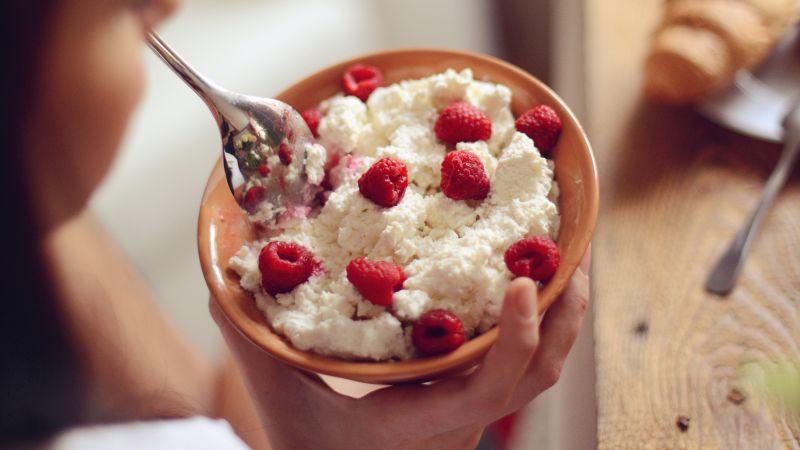Cottage cheese, once relegated to the diet-conscious section of grocery stores and often associated with bland health food, has unexpectedly surged back into the spotlight. According to John Crawford, Senior Vice President of Client Insights for dairy at Circana, the recent resurgence of interest in this lumpy cheese can largely be attributed to social media platform TikTok. With innovative recipes and creative culinary approaches flooding the app, younger generations are discovering the versatility and appeal of cottage cheese in a way that previous generations might not have considered.
Historically, cottage cheese was viewed as a health food staple from decades past, losing its charm among modern consumers. Data from Circana indicates a remarkable turnaround in cottage cheese sales, which saw a staggering 20% increase in US retail over the 52-week period ending June 15, compared to the previous year. This growth follows annual increases of 17% in previous years, marking a striking resurgence after a decline in 2021. Many could not have anticipated that ingredients once dismissed as outdated would spark such renewed interest in consumers today.
Notably, the increasing demand has caught the attention of industry leaders. For instance, Susan Morris, CEO of Albertsons, was surprised to learn that cottage cheese had transformed into a burgeoning market. “I had to double-check the numbers, but cottage cheese is actually a strong growth category,” she remarked during a July conference call relating to quarterly financial results. Some brands, like Organic Valley, have experienced even sharper spikes in demand; their sales grew over 30% in the first half of 2025 compared to the same timeframe the prior year.
The popularity of cottage cheese has reached a point where it has become challenging for many brands to supply their products to meet the soaring demand. Good Culture, a brand positioned prominently in TikTok’s rising culinary trends, has reported significant challenges keeping its products on the shelf. As highlighted in their social media communications, the company is deeply aware of their supply issues and has been actively working to resolve them. Jesse Merrill, their CEO, noted the intense demand, stating, “Customers call, email, and post about us when they can’t find us.” This response reinforces the mounting pressure on dairy producers to meet consumer needs.
In its evolution, cottage cheese is aligning closely with modern dietary preferences, particularly those prioritizing high-protein and low-sugar options. The rise of TL-coding or GLP-1 diets has seen an increasing number of health-conscious consumers gravitate toward products like cottage cheese. As inventive home chefs share unique recipes on social media, diverse dishes featuring cottage cheese have emerged, ranging from creamy ice creams to savory dips and bagels.
The continual exploration of cottage cheese has shifted its public perception as well. By the spring of 2023, internet culture was abuzz with viral recipes for cottage cheese-based ice creams in various creative flavors. TikTok influencers have amplified these recipes, converting cottage cheese from a mundane ingredient to a star player in innovative desserts and savory options alike. With a focus on how to enhance the flavor and texture of the product, brands like Cabot Creamery and Good Culture are leveraging their newfound popularity by issuing recipes and marketing directly to consumers.
While the demand has shown signs of sustainable growth, manufacturers face challenges in scaling production rapidly enough to keep pace with consumer needs. Good Culture has started to collaborate with additional manufacturing partners, although existing facilities are at maximum capacity. Similarly, Organic Valley and other dairy processors have begun expanding their production capabilities, but results will take time to materialize. New processing plants and upgraded equipment are essential to respond to demand swiftly.
Several companies, including Daisy Brand and Westby Cooperative Creamery, have undertaken expansion initiatives to increase their production of cottage cheese. Westby currently manufactures 14.5 million pounds of cottage cheese annually, yet they are seeing market orders exceed this amount by more than 30%. With commitments from current customers for increased volume paired with growing inquiries from new clients, the dairy industry is in the midst of a cottage cheese renaissance that holds promise for lasting impact in consumer sales.
As the landscape evolves, cottage cheese enthusiasts may need to exercise patience while suppliers ramp up their capabilities. Alternatively, they may anxiously wait for the next culinary fad to take social media by storm, as food trends are often transient. Yet, the current momentum indicates a promising future for cottage cheese, ensuring that it regains and possibly exceeds its former glory on the dinner table.












